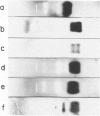Abstract
A diploid population of cultured rat hepatic epithelial cells that expresses the "oval" cell phenotype was exposed briefly and repetitively to N-methyl-N'-nitro-N-nitrosoguanidine (MNNG), and the effect on more than 20 phenotypic properties was evaluated during the neoplastic transformation of the population. MNNG treatments of this hepatic epithelial cell population resulted in a progressively increasing phenotypic alteration and heterogeneity including changes in specific activities of several cellular enzymes and expression of isozymes, synthetic functions, and various in vitro growth properties. Changes in phenotypic expression were clustered episodically and were associated with major karyotypic changes. The development of increasing phenotypic heterogeneity preceding and accompanying tumorigenicity in cultured liver epithelial cells in vitro and the specific phenotypes that occur resemble superficially the pattern of phenotypic changes that occur in hepatocytes during chemical hepatocarcinogenesis in vivo. The results of this study provide the basis for future investigations to further elucidate the mechanistic and linkage relationship between specific pretumorigenic and paratumorigenic phenotypes and tumorigenicity.
Full text
PDF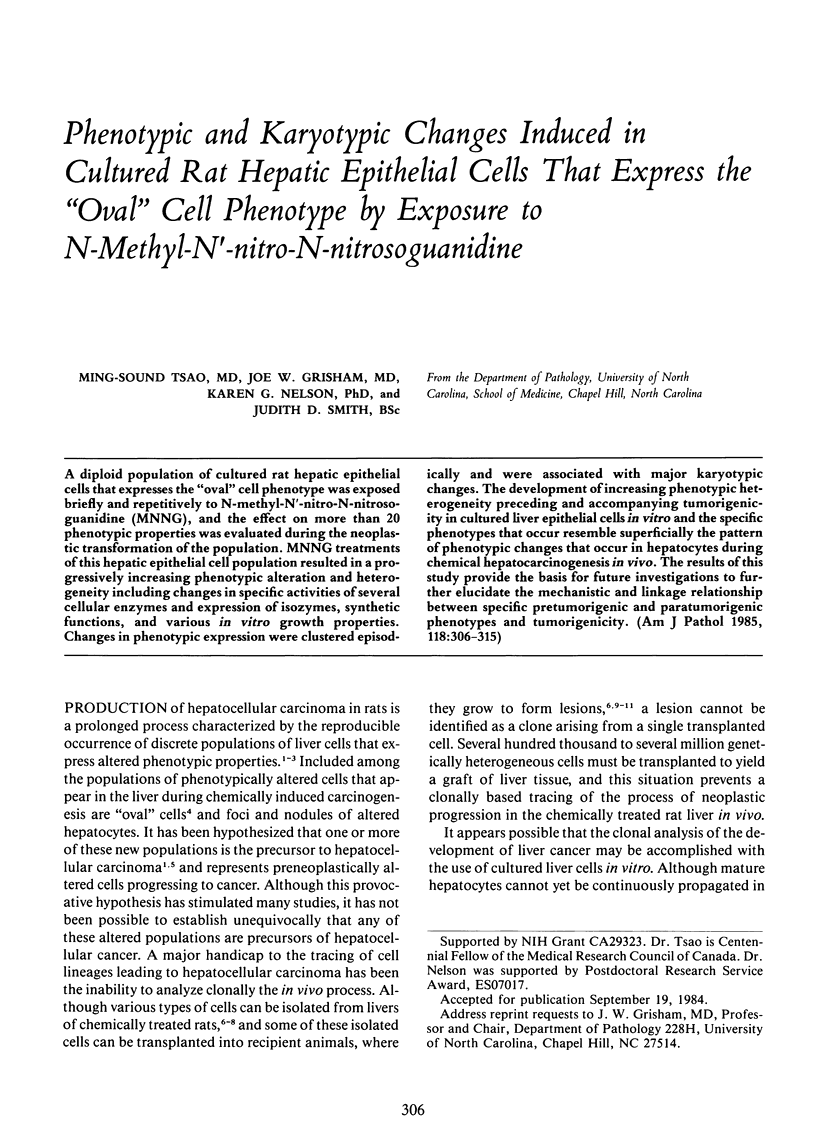
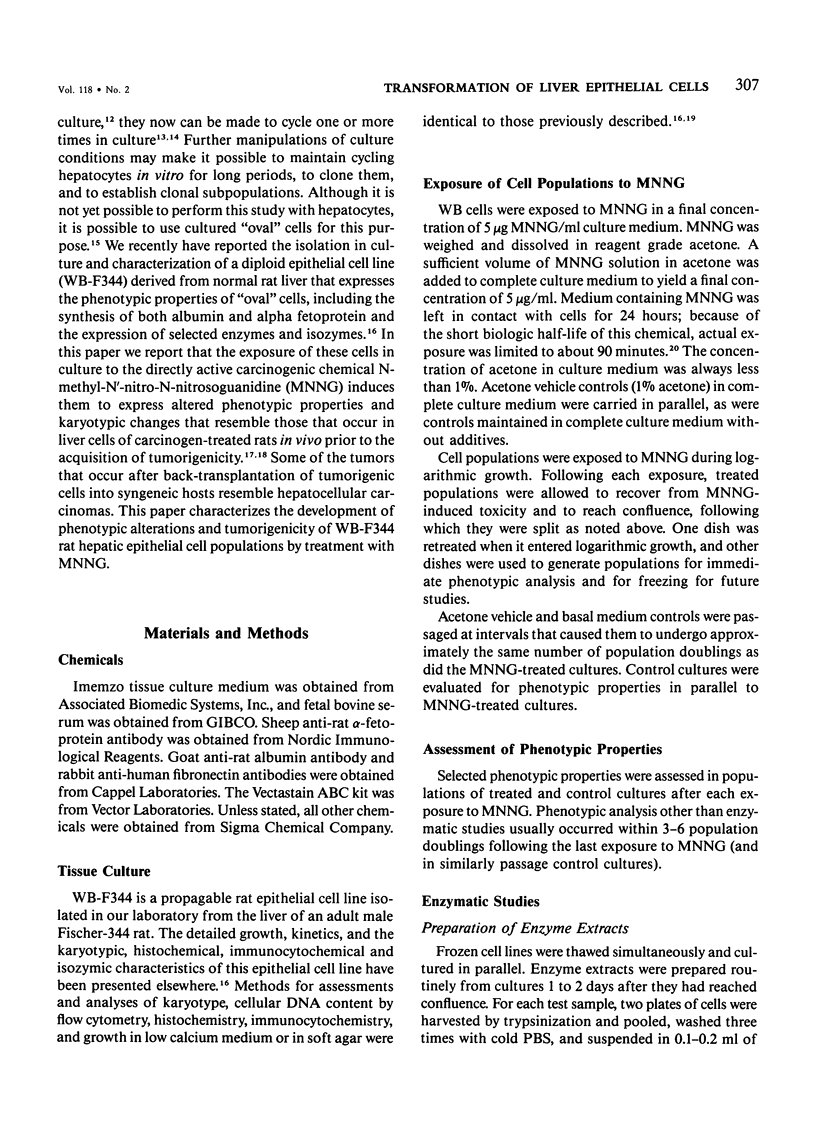
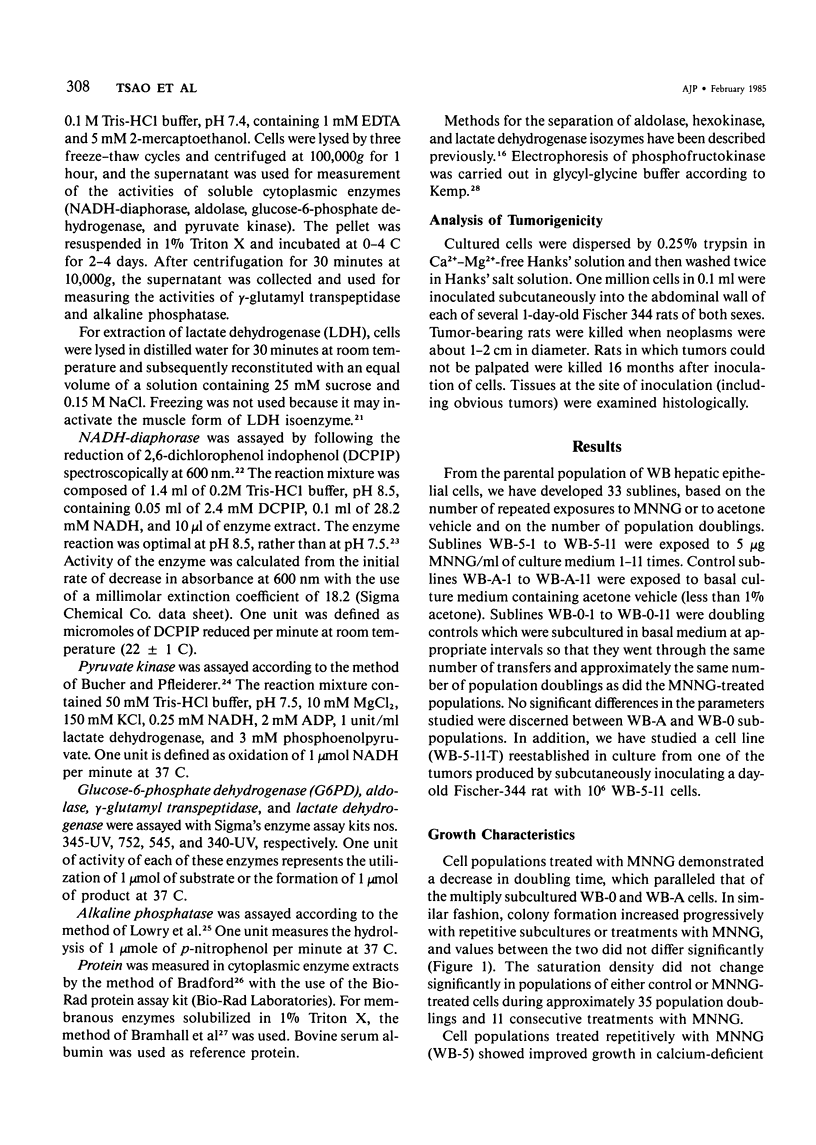
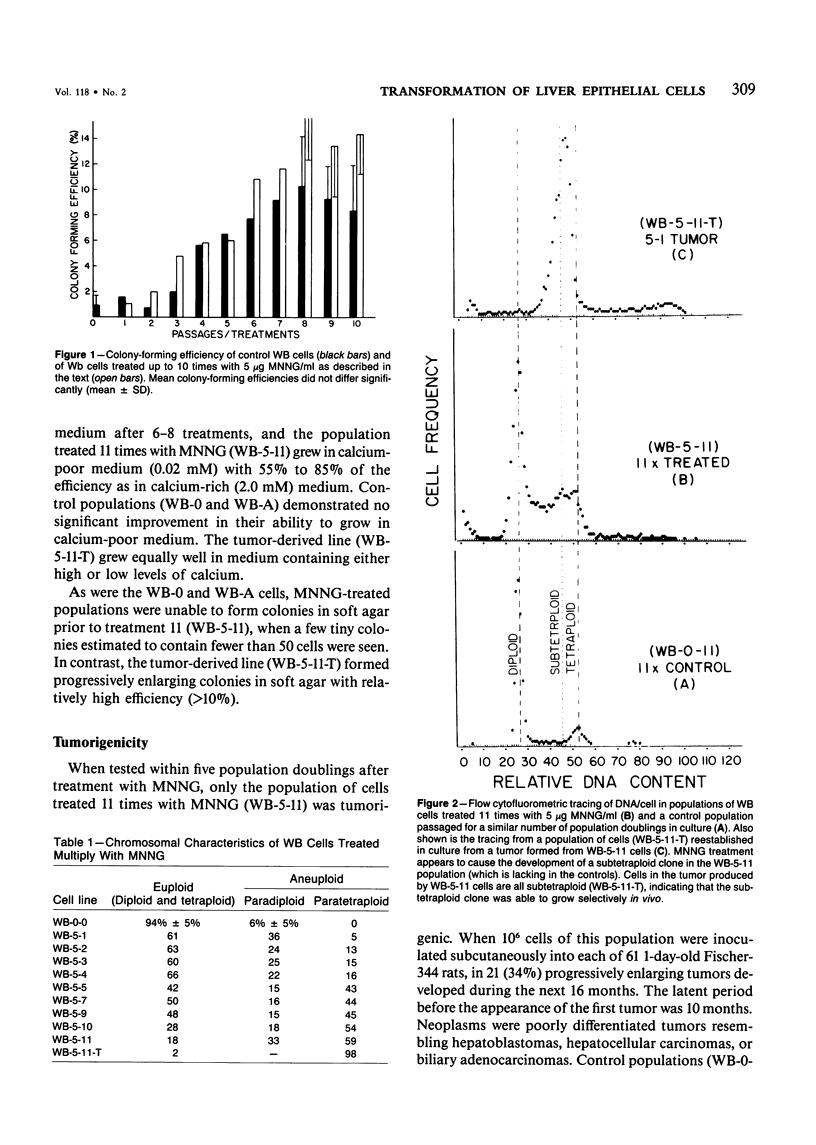
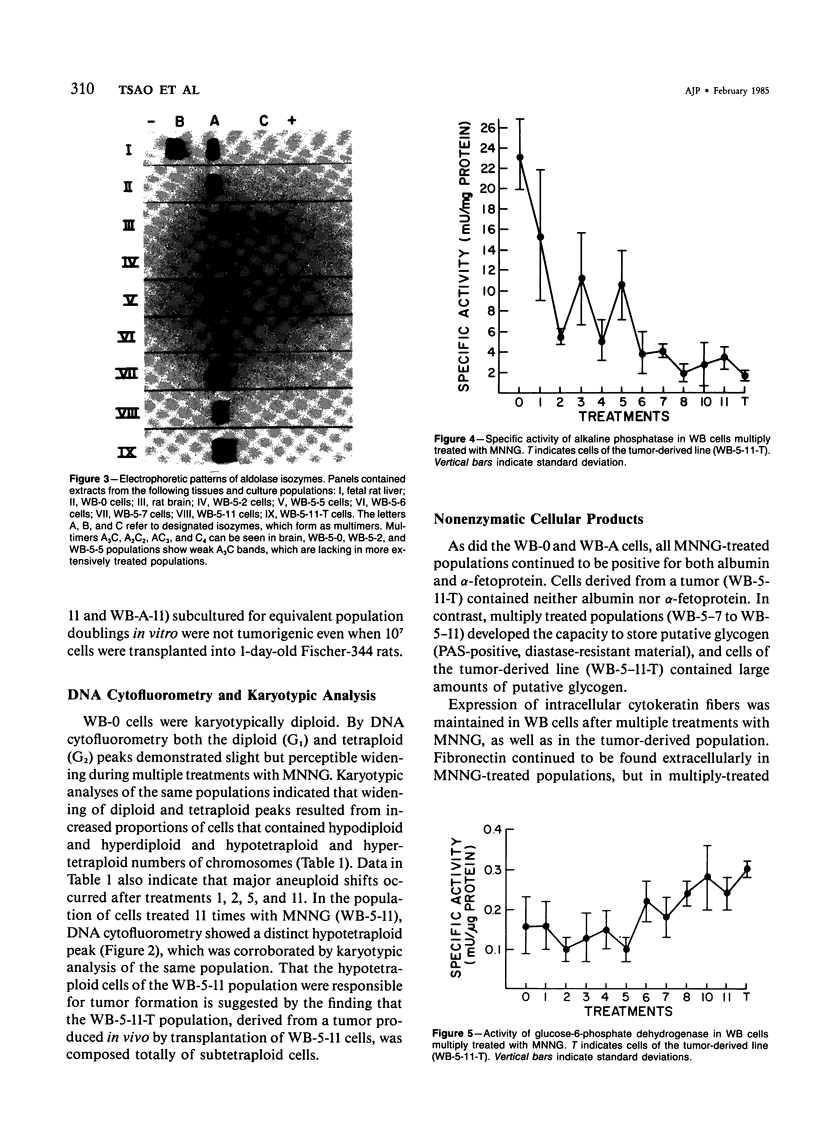
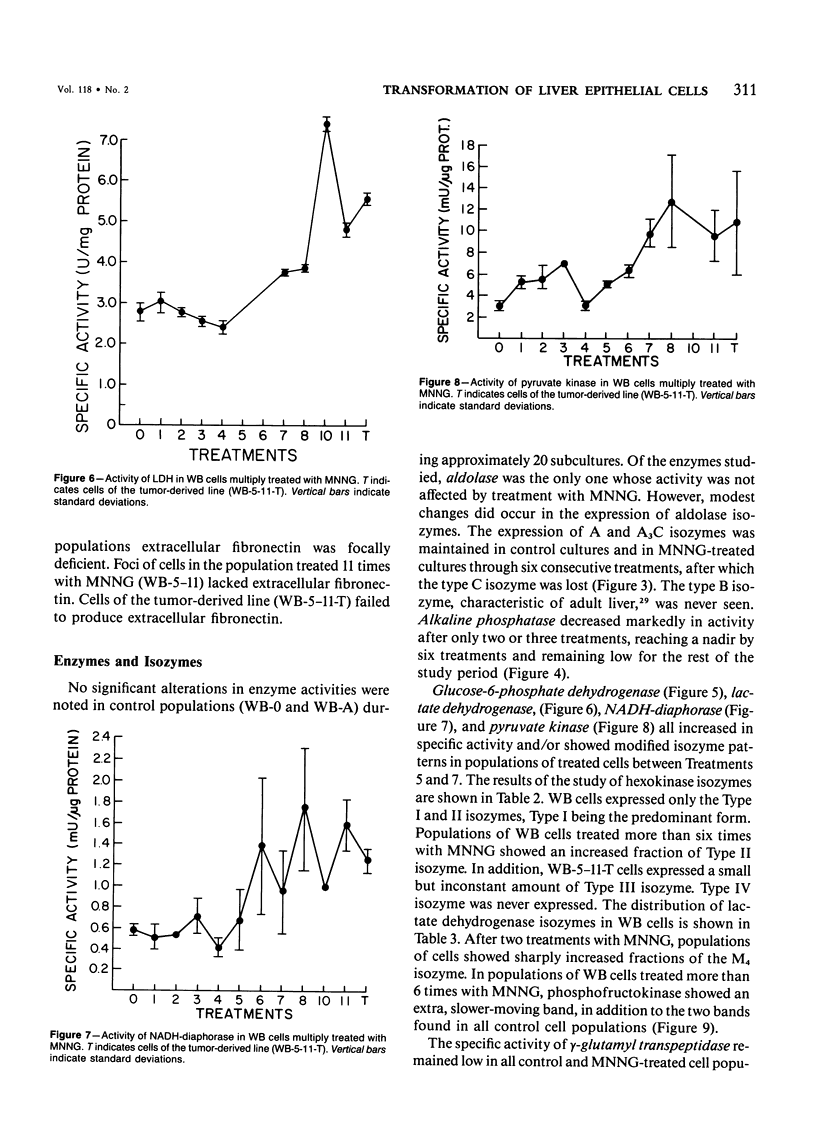
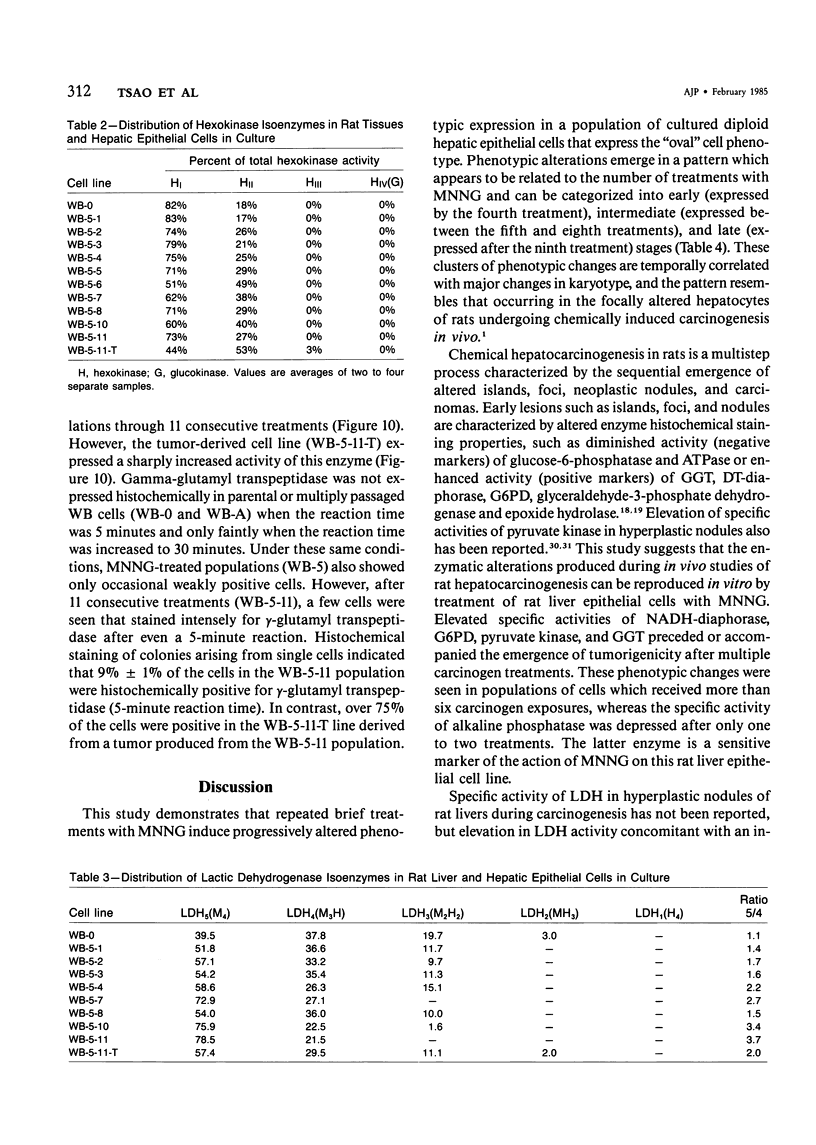
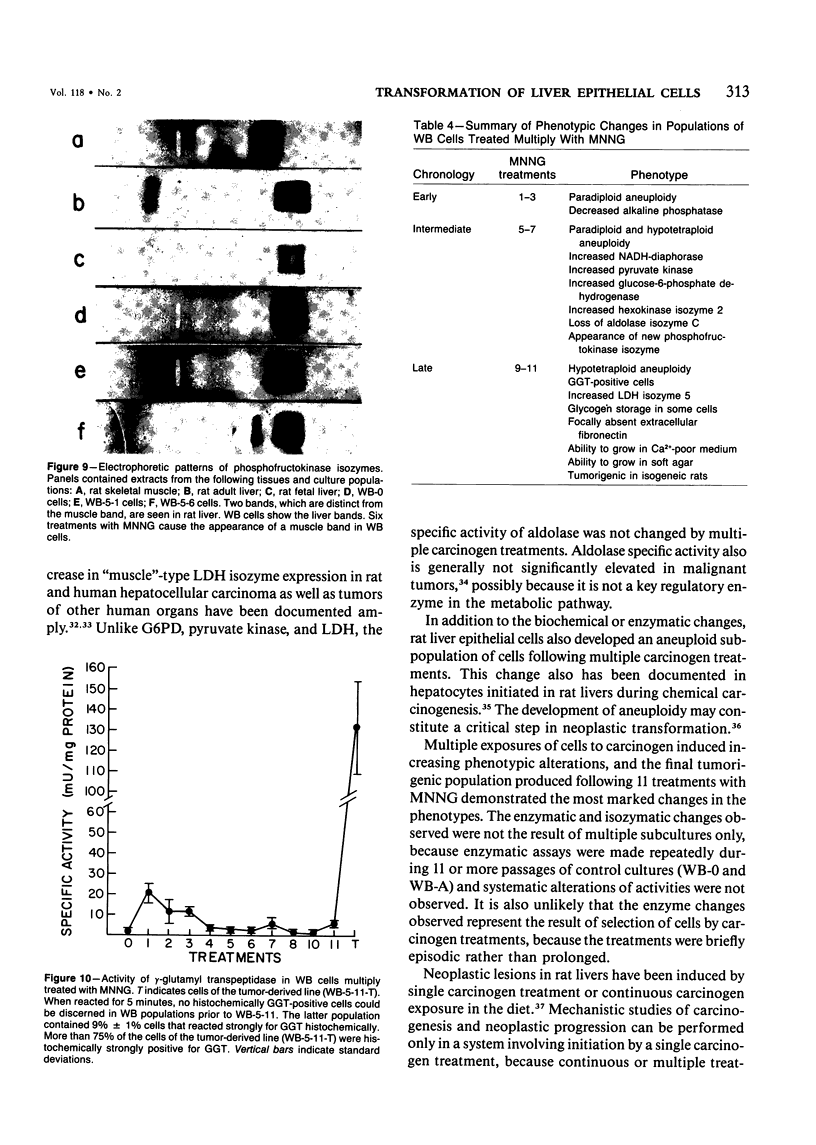
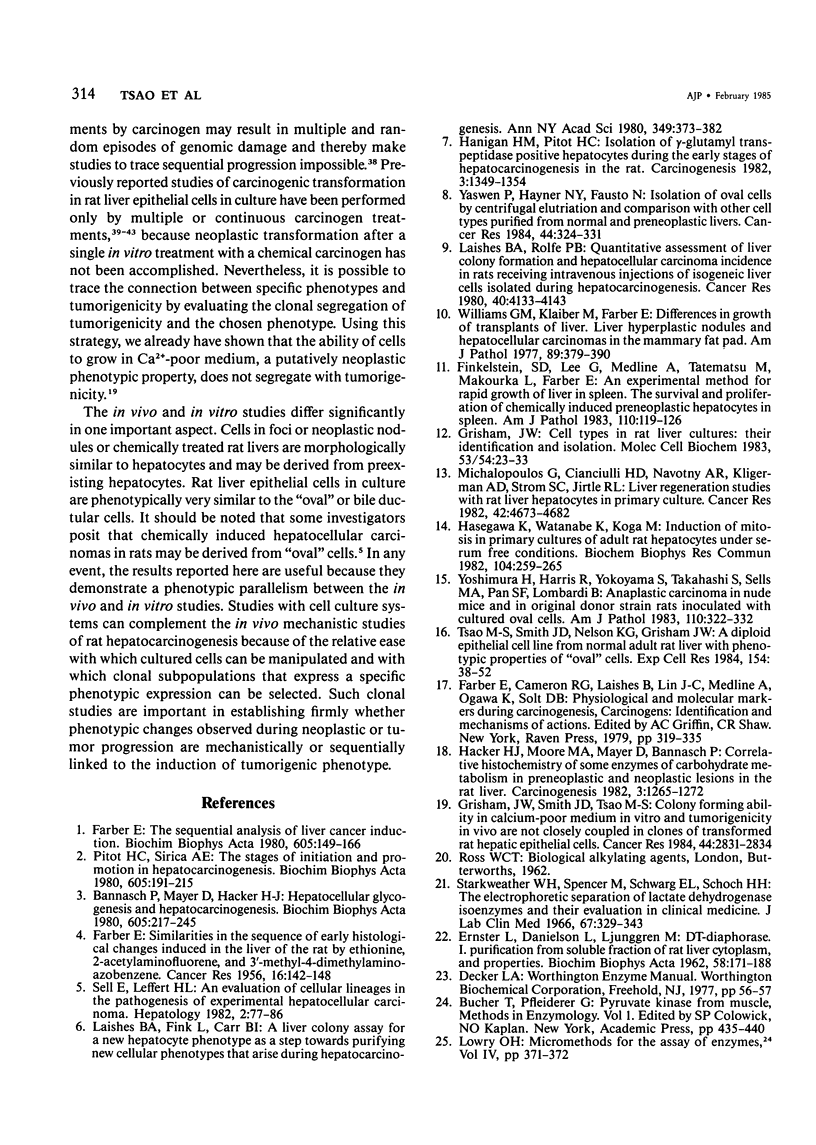
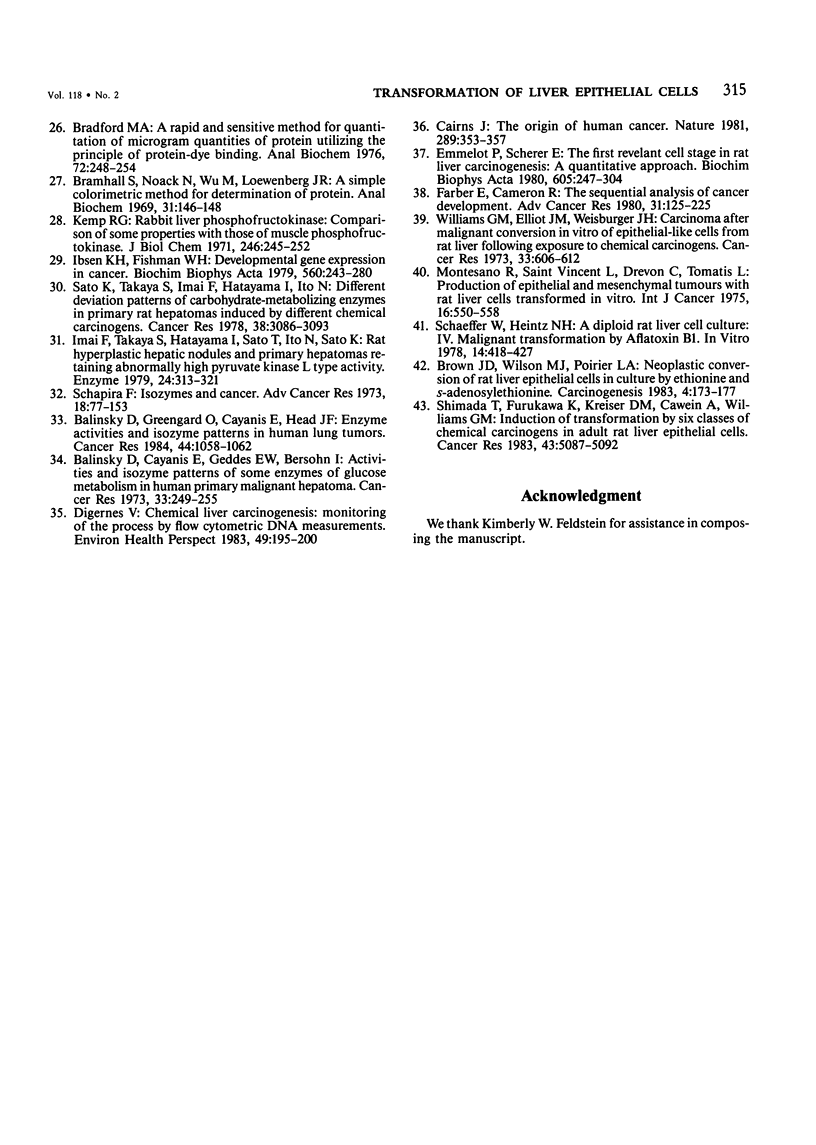
Images in this article
Selected References
These references are in PubMed. This may not be the complete list of references from this article.
- Balinsky D., Cayanis E., Geddes E. W., Bersohn I. Activities and isoenzyme patterns of some enzymes of glucose metabolism in human primary malignant hepatoma. Cancer Res. 1973 Feb;33(2):249–255. [PubMed] [Google Scholar]
- Balinsky D., Greengard O., Cayanis E., Head J. F. Enzyme activities and isozyme patterns in human lung tumors. Cancer Res. 1984 Mar;44(3):1058–1062. [PubMed] [Google Scholar]
- Bannasch P., Mayer D., Hacker H. J. Hepatocellular glycogenosis and hepatocarcinogenesis. Biochim Biophys Acta. 1980 May 6;605(2):217–245. doi: 10.1016/0304-419x(80)90005-0. [DOI] [PubMed] [Google Scholar]
- Bradford M. M. A rapid and sensitive method for the quantitation of microgram quantities of protein utilizing the principle of protein-dye binding. Anal Biochem. 1976 May 7;72:248–254. doi: 10.1006/abio.1976.9999. [DOI] [PubMed] [Google Scholar]
- Bramhall S., Noack N., Wu M., Loewenberg J. R. A simple colorimetric method for determination of protein. Anal Biochem. 1969 Oct 1;31(1):146–148. doi: 10.1016/0003-2697(69)90251-6. [DOI] [PubMed] [Google Scholar]
- Brown J. D., Wilson M. J., Poirier L. A. Neoplastic conversion of rat liver epithelial cells in culture by ethionine and S-adenosylethionine. Carcinogenesis. 1983;4(2):173–177. doi: 10.1093/carcin/4.2.173. [DOI] [PubMed] [Google Scholar]
- Cairns J. The origin of human cancers. Nature. 1981 Jan 29;289(5796):353–357. doi: 10.1038/289353a0. [DOI] [PubMed] [Google Scholar]
- Digernes V. Chemical liver carcinogenesis: monitoring of the process by flow cytometric DNA measurements. Environ Health Perspect. 1983 Apr;50:195–200. doi: 10.1289/ehp.8350195. [DOI] [PMC free article] [PubMed] [Google Scholar]
- ERNSTER L., DANIELSON L., LJUNGGREN M. DT diaphorase. I. Purification from the soluble fraction of rat-liver cytoplasm, and properties. Biochim Biophys Acta. 1962 Apr 9;58:171–188. doi: 10.1016/0006-3002(62)90997-6. [DOI] [PubMed] [Google Scholar]
- Emmelot P., Scherer E. The first relevant cell stage in rat liver carcinogenesis. A quantitative approach. Biochim Biophys Acta. 1980 May 6;605(2):247–304. doi: 10.1016/0304-419x(80)90006-2. [DOI] [PubMed] [Google Scholar]
- FARBER E. Similarities in the sequence of early histological changes induced in the liver of the rat by ethionine, 2-acetylamino-fluorene, and 3'-methyl-4-dimethylaminoazobenzene. Cancer Res. 1956 Feb;16(2):142–148. [PubMed] [Google Scholar]
- Farber E., Cameron R. The sequential analysis of cancer development. Adv Cancer Res. 1980;31:125–226. doi: 10.1016/s0065-230x(08)60658-2. [DOI] [PubMed] [Google Scholar]
- Farber E. The sequential analysis of liver cancer induction. Biochim Biophys Acta. 1980 May 6;605(2):149–166. doi: 10.1016/0304-419x(80)90002-5. [DOI] [PubMed] [Google Scholar]
- Finkelstein S. D., Lee G., Medline A., Tatematsu M., Makowka L., Farber E. An experimental method for rapid growth of liver in spleen. The survival and proliferation of chemically induced preneoplastic hepatocytes in spleen. Am J Pathol. 1983 Feb;110(2):119–126. [PMC free article] [PubMed] [Google Scholar]
- Grisham J. W. Cell types in rat liver cultures: their identification and isolation. Mol Cell Biochem. 1983;53-54(1-2):23–33. doi: 10.1007/BF00225244. [DOI] [PubMed] [Google Scholar]
- Grisham J. W., Smith J. D., Tsao M. S. Colony-forming ability in calcium-poor medium in vitro and tumorigenicity in vivo not coupled in clones of transformed rat hepatic epithelial cells. Cancer Res. 1984 Jul;44(7):2831–2834. [PubMed] [Google Scholar]
- Hacker H. J., Moore M. A., Mayer D., Bannasch P. Correlative histochemistry of some enzymes of carbohydrate metabolism in preneoplastic and neoplastic lesions in the rat liver. Carcinogenesis. 1982;3(11):1265–1272. doi: 10.1093/carcin/3.11.1265. [DOI] [PubMed] [Google Scholar]
- Hanigan H. M., Pitot H. C. Isolation of gamma-glutamyl transpeptidase positive hepatocytes during the early stages of hepatocarcinogenesis in the rat. Carcinogenesis. 1982;3(11):1349–1354. doi: 10.1093/carcin/3.11.1349. [DOI] [PubMed] [Google Scholar]
- Hasegawa K., Watanabe K., Koga M. Induction of mitosis in primary cultures of adult rat hepatocytes under serum-free conditions. Biochem Biophys Res Commun. 1982 Jan 15;104(1):259–265. doi: 10.1016/0006-291x(82)91968-4. [DOI] [PubMed] [Google Scholar]
- Ibsen K. H., Fishman W. H. Developmental gene expression in cancer. Biochim Biophys Acta. 1979 Aug 10;560(2):243–280. doi: 10.1016/0304-419x(79)90021-0. [DOI] [PubMed] [Google Scholar]
- Imai F., Takaya S., Hatayama I., Sato T., Ito N., Sato K. Rat hyperplastic hepatic nodules and primary hepatomas retaining abnormally high pyruvate kinase L type activity. Enzyme. 1979;24(5):313–321. doi: 10.1159/000458681. [DOI] [PubMed] [Google Scholar]
- Kemp R. G. Rabbit liver phosphofructokinase. Comparison of some properties with those of muscle phosphofructokinase. J Biol Chem. 1971 Jan 10;246(1):245–252. [PubMed] [Google Scholar]
- Laishes B. A., Fink L., Carr B. I. A liver colony assay for a new hepatocyte phenotype as a step toward purifying new cellular phenotypes that arise during hepatocarcinogenesis. Ann N Y Acad Sci. 1980;349:373–382. doi: 10.1111/j.1749-6632.1980.tb29540.x. [DOI] [PubMed] [Google Scholar]
- Laishes B. A., Rolfe P. B. Quantitative assessment of liver colony formation and hepatocellular carcinoma incidence in rats receiving intravenous injections of isogeneic liver cells isolated during hepatocarcinogenesis. Cancer Res. 1980 Nov;40(11):4133–4143. [PubMed] [Google Scholar]
- Michalopoulos G., Cianciulli H. D., Novotny A. R., Kligerman A. D., Strom S. C., Jirtle R. L. Liver regeneration studies with rat hepatocytes in primary culture. Cancer Res. 1982 Nov;42(11):4673–4682. [PubMed] [Google Scholar]
- Montesano R., Saint Vincent L., Drevon C., Tomatis L. Production of epithelial and mesenchymal tumours with rat liver cells transformed in vitro. Int J Cancer. 1975 Oct 15;16(4):550–558. doi: 10.1002/ijc.2910160405. [DOI] [PubMed] [Google Scholar]
- Pitot H. C., Sirica A. E. The stages of initiation and promotion in hepatocarcinogenesis. Biochim Biophys Acta. 1980 May 6;605(2):191–215. doi: 10.1016/0304-419x(80)90004-9. [DOI] [PubMed] [Google Scholar]
- Sato K., Takaya S., Imai F., Hatayama I., Ito N. Different deviation patterns of carbohydrate-metabolizing enzymes in primary rat hepatomas induced by different chemical carcinogens. Cancer Res. 1978 Sep;38(9):3086–3093. [PubMed] [Google Scholar]
- Schaeffer W. I., Heintz N. H. A diploid rat liver cell culture. IV. Malignant transformation by aflatoxin B1. In Vitro. 1978 May;14(5):418–427. doi: 10.1007/BF02616103. [DOI] [PubMed] [Google Scholar]
- Schapira F. Isozymes and cancer. Adv Cancer Res. 1973;18:77–153. doi: 10.1016/s0065-230x(08)60751-4. [DOI] [PubMed] [Google Scholar]
- Sell S., Leffert H. L. An evaluation of cellular lineages in the pathogenesis of experimental hepatocellular carcinoma. Hepatology. 1982 Jan-Feb;2(1):77–86. doi: 10.1002/hep.1840020113. [DOI] [PubMed] [Google Scholar]
- Shimada T., Furukawa K., Kreiser D. M., Cawein A., Williams G. M. Induction of transformation by six classes of chemical carcinogens in adult rat liver epithelial cells. Cancer Res. 1983 Nov;43(11):5087–5092. [PubMed] [Google Scholar]
- Starkweather W. H., Spencer H. H., Schwarz E. L., Schoch H. K. The electrophoretic separation of lactate dehydrogenase isoenzymes and their evaluation in clinical medicine. J Lab Clin Med. 1966 Feb;67(2):329–343. [PubMed] [Google Scholar]
- Tsao M. S., Smith J. D., Nelson K. G., Grisham J. W. A diploid epithelial cell line from normal adult rat liver with phenotypic properties of 'oval' cells. Exp Cell Res. 1984 Sep;154(1):38–52. doi: 10.1016/0014-4827(84)90666-9. [DOI] [PubMed] [Google Scholar]
- Williams G. M., Elliott J. M., Weisburger J. H. Carcinoma after malignant conversion in vitro of epithelial-like cells from rat liver following exposure to chemical carcinogens. Cancer Res. 1973 Mar;33(3):606–612. [PubMed] [Google Scholar]
- Williams G. M., Klaiber M., Farber E. Differences in growth of transplants of liver, liver hyperplastic nodules, and hepatocellular carcinomas in the mammary fat pad. Am J Pathol. 1977 Nov;89(2):379–390. [PMC free article] [PubMed] [Google Scholar]
- Yaswen P., Hayner N. T., Fausto N. Isolation of oval cells by centrifugal elutriation and comparison with other cell types purified from normal and preneoplastic livers. Cancer Res. 1984 Jan;44(1):324–331. [PubMed] [Google Scholar]
- Yoshimura H., Harris R., Yokoyama S., Takahashi S., Sells M. A., Pan S. F., Lombardi B. Anaplastic carcinomas in nude mice and in original donor strain rats inoculated with cultured oval cells. Am J Pathol. 1983 Mar;110(3):322–332. [PMC free article] [PubMed] [Google Scholar]




